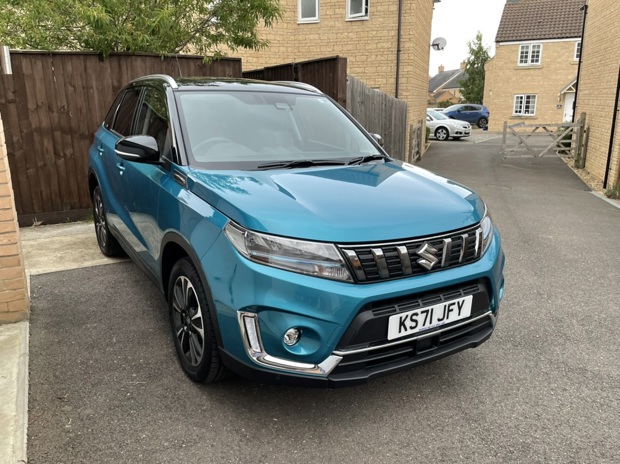We welcome the Suzuki Vitara Full Hybrid (and its giant car cardigan)
It's no ordinary handover when we collect the keys to the Suzuki Vitara Full Hybrid.

Date: 3 August 2022 | Current mileage: 1,403 | Claimed economy: 53.0mpg | Actual economy: 47.9mpg
After saying farewell to the Suzuki Swace, we’ve welcomed the Vitara full hybrid for a three-month test.
The fourth generation of the Vitara was launched back in 2015 and has since undergone a number of updates, including the introduction of a 1.4-litre mild hybrid petrol engine in 2020 and now, in 2022, the range has been expanded with the addition of the more powerful 1.5-litre ‘full’ hybrid.
Unlike the Swace, the Vitara doesn’t use Toyota’s hybrid technology and also features Suzuki’s Auto Gear Shift (AGS) technology as standard. Automated manuals aren’t that common but Suzuki says it introduced it to the Vitara for the weight-saving benefit and improved fuel economy compared with a conventional torque-converter automatic.
The advice I was given when I collected the keys to the Vitara at Suzuki’s head office was that the AGS works best with gentle acceleration. It'll be interesting to see what that means in reality over the coming months.

It’s no ordinary handover as Suzuki’s reception area pays homage to the car maker’s new TV advert and brand positioning, known as “Good different”. The quirky TV advert features two ‘grandmas’ knitting giant cardigans to “create the warm fuzzy feeling” that comes with Suzuki’s cars.
The advert boasts that Suzuki’s range “comes packed with the tech you need as standard”. While it’s debatable whether you need every single tech feature fitted to the Vitara there’s no denying it is generously equipped and, as we noted with the Swace, it does away with optional safety or ‘comfort’ packs in favour of simplicity.
Standard equipment on the SZ-T model includes seven airbags, LED lights, USB and bluetooth connectivity, Smartphone link audio and navigation system, keyless entry and start, rear privacy glass, adaptive cruise control, and other safety technology such as blind spot monitor, traffic sign recognition, rear cross traffic alert and automated emergency braking.
Our top spec SZ5 has suede seat upholstery, a panoramic sunroof, front and rear parking sensors, and has dual-tone paint (Atlantis Turquoise Pearl Metallic with Cosmic Black Pearl Metallic Roof) for £835. You can also specify four wheel drive, which Suzuki calls ALLGRIP. Whether it also comes with a “warm fuzzy feeling” we’ll soon find out.
What’s the Suzuki Vitara Full Hybrid’s interior like?
We take a closer look at the Suzuki Vitara Full Hybrid’s interior and its panoramic roof.
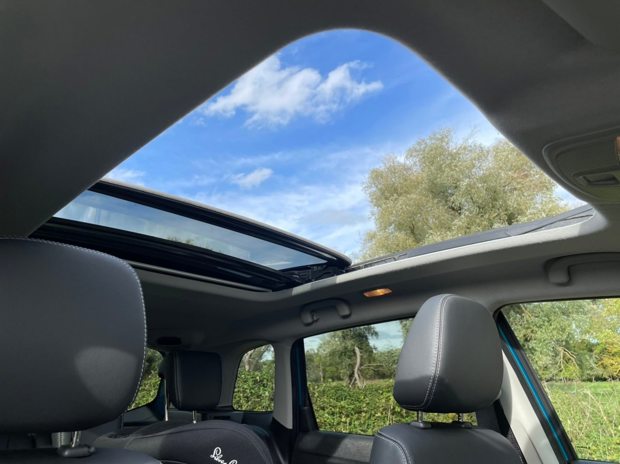
Date: 24 August 2022 | Current mileage: 2,697 | Claimed economy: 53.0mpg | Actual economy: 48.0mpg
“Open the roof mummy, open the roof mummy. OPEN THE ROOF MUMMYEEE.”
Those are usually the first word’s out of my three-year-old’s mouth once she’s strapped into her car seat and we are about to set off.
The novelty of the Vitara Hybrid’s double sliding panoramic sunroof, which is standard fit on our top-of-the-range SZ5, hasn’t worn off for my daughter. It’s been a real joy to open it on sunny days, and when it’s been too hot with the recent heatwave there’s a cover that stops the sun beating down through the glass.
With the cover retracted the Vitara’s cabin has a light and airy feel, further enhanced by a long windscreen and tall side windows boosting visibility. Sitting higher up in the Vitara gives you a commanding view of the road in contrast to the Suzuki Swace estate I was previously testing. It’s one of the reasons why so many people like to drive SUVs.
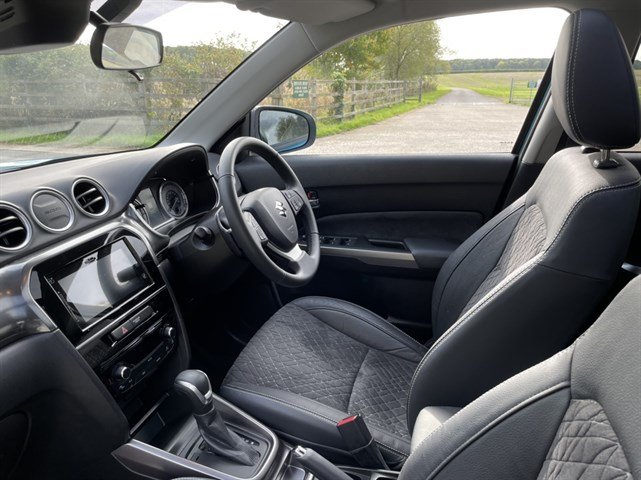
The seats themselves are a nice, soft suede (again, you have to specify the SZ5 to get these as standard). It’s not too difficult to find a comfortable driving position, although there’s no electric seat adjustment and no adjustable lumbar support.
The rest of the interior is sightly spoilt by some hard, less-than-premium plastics. The silver fascia adds some interest to what is otherwise a fairly bland interior (at least compared to the Vitara’s striking exterior turquoise metallic paint).
Sat-nav is standard in the Vitara Hybrid (unlike the Swace) but it also comes with smartphone connectivity so you can use Apple CarPlay or Android Auto if you prefer. At seven inches the screen is slightly on the small size and isn’t the most responsive, but traditional dials and buttons to control the air conditioning are welcome.
Boot space for the full hybrid is a rather disappointing 289 litres, compared with 375 litres in the standard Vitara. I’ll find out if that proves to be enough for a family holiday next month.
How does the Suzuki Vitara Full Hybrid work?
Our Suzuki Vitara is a ‘full’ hybrid (rather than a mild or plug-in hybrid). Here we explain what that means and what the benefits of the technology are.
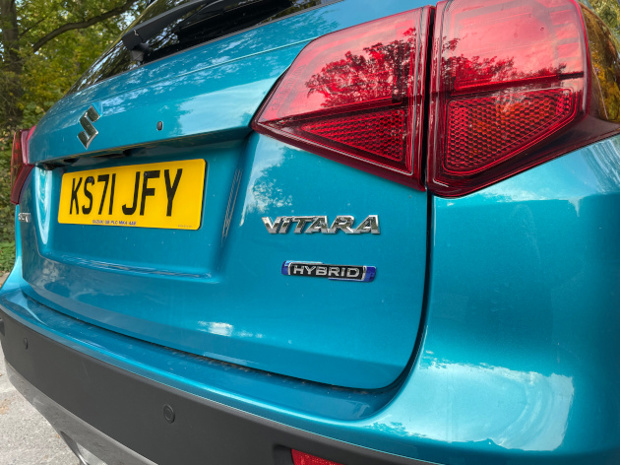
Date: 14 September 2022 | Current mileage: 3,176 | Claimed economy: 53.0mpg | Actual economy: 48.0mpg
The term 'hybrid car' can be a confusing one as there are different degrees of hybrid - mild hybrid, full hybrid, plug-in hybrid. Then there’s the question of whether it’s a diesel hybrid or petrol hybrid - the former isn't as common but does exist.
Suzuki offers both petrol mild hybrid and full hybrid versions of the Vitara. There’s no plug-in hybrid offered - such a car would come with a much bigger battery and more usable electric range, but the downside is you need to plug them in to get the best efficiency, while they usually cost thousands more to buy.
The full hybrid Suzuki Vitara we’re testing comes with a 1.5-litre non-turbocharged petrol engine, a 140 volt lithium-ion battery and inverter, motor generator unit (MGU), a 12v lithium-ion battery as well as a conventional 12v lead-acid battery to power components that use lower voltages such as lights and heating/air conditioning.
Sounds complicated? It’s a pretty well-established system now and something that fellow Japanese brand Toyota has been championing for many years now.
Unlike the mild hybrid it’s possible to run the Vitara on electric power alone for very short distances - very short being the operative word given the tiny 0.84kWh battery pack. It’ll mooch about in smooth silence when you’re doing low-speed town work, however.
Really where the Suzuki Vitara Full Hybrid excels is by juggling both power sources. Regenerative braking and coasting helps top up the battery in normal driving, allowing the system to switch between petrol power, electric power or a combination of both to maximise efficiency. It’ll cut the engine when demand for acceleration is low, such as when you’re cruising below 50mph.
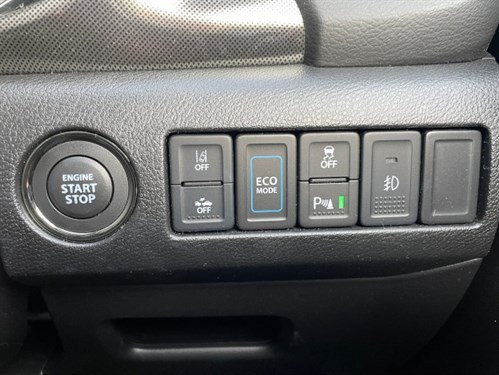
There are two drive modes available: standard and eco. Eco mode increases the frequency of electric driving. When this is selected acceleration is notably constrained and different air conditioning modes can’t be used, so it’s only for the committed.
Standard mode allows for more “spirited driving enjoyment”, according to Suzuki, with power rather than fuel economy being prioritised.
Considering 0-62mph already takes a fairly leisurely 12.7 seconds and the automated manual gearbox can be slow to change gears as it is, I’ve been keeping the Vitara in standard mode. Suzuki claims the electric motors help ‘fill’ the gearshifts with electric torque, and this does work in more gentle driving, but hard acceleration exposes its flaws.
In standard mode I’ve been achieving average fuel economy of 48mpg, which is 5mpg below the official combined figure of 53mpg. It’s a decent figure given the mix of town and rural road driving I do, but rival full hybrid models like the Toyota Yaris Cross can do a fair bit better.
Interestingly, that’s almost identical to the overall figure we achieved when running a 1.6-litre pure petrol, four-wheel drive Suzuki Vitara in 2015. Admittedly it’s different drivers and different routes, but whether the full hybrid works better than the (very nearly as efficient on paper) mild hybrid model depends on your individual situation.
How practical is the Suzuki Vitara Full Hybrid?
We test the Suzuki Vitara Full Hybrid’s practicality with the ever-demanding family holiday
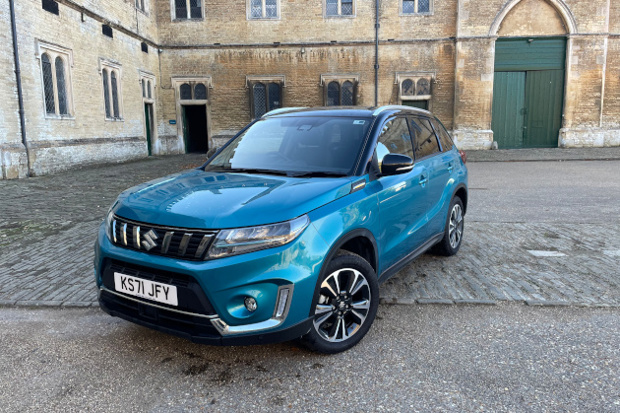
Date: 28 September 2022 | Current mileage: 3,790 | Claimed economy: 53.0mpg | Actual economy: 48.0mpg
I hold my hands up, I usually overpack for a family holiday, especially if it’s a self-catering staycation where it’s all too easy to put things in the boot ‘just in case’ we need them.
Luckily for the Vitara, our recent holiday was abroad by plane which meant I had luggage restrictions to adhere to.
We still ended up with two large suitcases, one cabin-size suitcase, two rucksacks and a pushchair. As the picture below shows, our Vitara Full Hybrid’s boot did cope with all of that thanks to the 60:40 rear seat split, necessary to increase the boot space from the disappointing on-paper figure of 289 litres - down from 375 litres in the Vitara mild-hybrid.
Like many hybrids and fully electric cars, the Vitara’s boot space is reduced by the batteries beneath the boot floor. For a bigger boot in the small SUV class you’ll need to look to the likes of the Volkswagen T-Cross which offers 385-455 litres (depending on how you position the variable-height boot floor), rising to 1,281 litres with the seats folded, or the Ford Puma (456 litres, including its MegaBox feature).
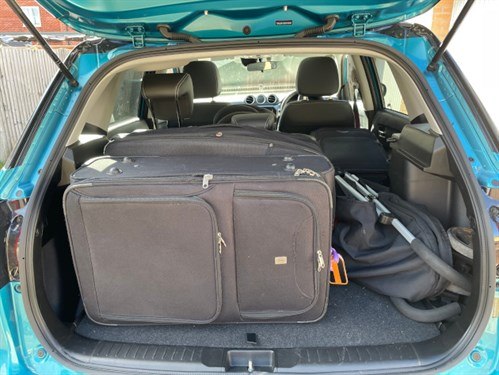
The Vitara Full Hybrid doesn’t have the largest boot in this sector, then, but that figure is measured up to the parcel shelf - if you remove that the boxy small SUV shape allows tall loads. Its low loading lip makes it easy to get items in and out, while it’s also a handy square shape.
Elsewhere in the Vitara, the front door pockets are big enough to hold 1.5-litre bottles, there are a pair of cupholders in the centre console (although oddly they’re more of a square shape than a circle), sunglasses storage and a handy shelf for placing your phone next to the USB socket.
Rear passenger headroom is slightly compromised by the panoramic sunroof, but that’s a feature both I and the kids have enjoyed. With no member of the family being over six-foot tall headroom has never been an issue.
Farewell to the Suzuki Vitara Full Hybrid
After three months we’re saying goodbye to the Suzuki Vitara Full Hybrid
Date: 12 October 2022 | Current mileage: 4,453 | Claimed economy: 53.0mpg | Actual economy: 49.0mpg
After three months and 4,450 miles we’re saying goodbye to the Suzuki Vitara Full Hybrid.
It’s the first small SUV I’ve run for a while after some back-to-back tests of estate cars, and it’s reminded me how much better the view is when you sit higher up, which is one of the main attractions of this type of car.
Great visibility of the road ahead is complemented by the Vitara’s panoramic sunroof, which I have really enjoyed over the summer months. It gives the whole cabin a light and airy feel and the novelty of opening it on a warm day made it a hit with my three-year-old daughter too.
Aesthetically, the Vitara is like a cut-price Range Rover Evoque, which I like, and its chunky looks can be enhanced with the ‘rugged design pack’ for £1,595, which adds features such as front and rear skid plates, side body moulding, and accent lines to the front bumper and grille.
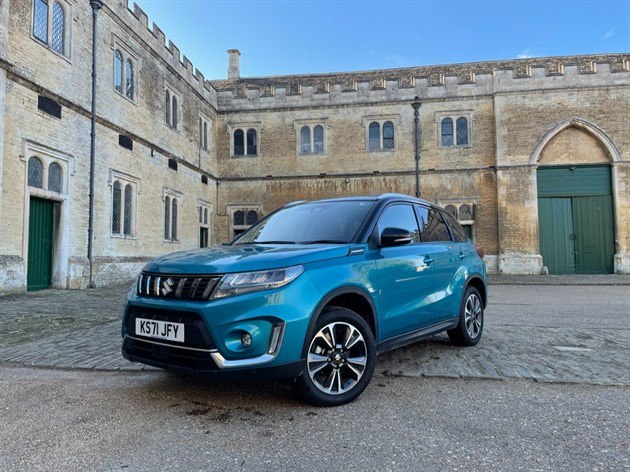
Unlike many other compact SUVs, the Vitara actually has four-wheel drive capability with an ALLGRIP version available for an extra £1,800, compared to the standard two-wheel drive SZ5 we’ve been testing.
As with the Swace we tested previously, I’ve been really impressed with the level of standard equipment on the Vitara. Entry-level SZ-T includes LED headlamps, USB and Bluetooth connectivity, Traffic Sign Recognition, Blind Spot Monitor, Adaptive Cruise Control, auto air conditioning and front and rear electric windows, keyless entry and start, rear privacy glass, Smartphone link audio and navigation system. Our top trim level SZ5 adds 17-inch polished alloy wheels, suede seat upholstery, front and rear parking sensors, and the panoramic sunroof.
Fuel economy during our three-month test has been pretty good too. I’ve recently reached an average of 49mpg, which is just 4mpg below the official combined figure of 53mpg, and that’s without doing a lot of city centre driving which best suits the Vitara’s hybrid engine.
The downside of the Vitara being hybrid is that its boot space is reduced due to the batteries being beneath the boot floor but we found there was still ample room for the family luggage, meaning the Vitara does most things pretty well.

